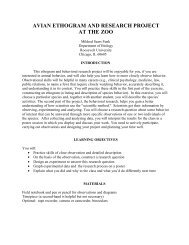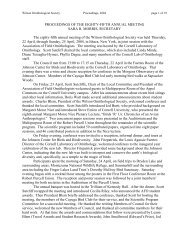Available now - Wilson Ornithological Society
Available now - Wilson Ornithological Society
Available now - Wilson Ornithological Society
You also want an ePaper? Increase the reach of your titles
YUMPU automatically turns print PDFs into web optimized ePapers that Google loves.
WOS 2010 ~ ABSTRACTS p. 26<br />
density were similar between nest sites and random sites. These habitat characteristics are typical at sites where<br />
forest thinning and prescribed fire are used to manage Red-cockaded Woodpecker habitat. We recorded 371 prey<br />
deliveries (males = 195, females = 176) to nest sites by breeding pairs. Most vertebrate prey was delivered by males<br />
(86%), with green anoles (Anolis carolinensis) being the most common prey item (n = 104). Females delivered<br />
mostly invertebrates (88%), and grasshoppers were the most common prey item (n = 54).<br />
43 Influence of seeded, exotic grasslands on wintering birds in mixed-grass prairie. Timothy J. O’Connell and<br />
Andrew D. George, Dept. Natural Resource Ecology and Management, Oklahoma State Univ., Stillwater, OK,<br />
74078.<br />
Millions of hectares of U. S. cropland have been converted to seeded grasslands through enrollment in the<br />
Conservation Reserve Program (CRP) since the 1980s. The majority of those lands have been seeded with exotic,<br />
invasive Old World bluestems (OWB) that are <strong>now</strong> abundant CRP fields and in managed hayfields. In the U.S.<br />
Southern Plains, several species of conservation priority winter in grasslands; the use of OWB by these species has<br />
not been investigated. We surveyed 6 fields of native grasses and 6 fields of OWB monoculture during two winters<br />
(2008–2009) in Oklahoma to test the hypothesis that richness, abundance of target species, and avian conservation<br />
value was similar between the two types of grass cover. Transect surveys revealed 31 species in the fields over the<br />
two seasons, of which 16 occurred exclusively in native grass fields and 4 occurred exclusively in OWB fields.<br />
Despite these differences, neither mean richness nor diversity differed between the two types of fields. Conservation<br />
value, when weighted by abundance, was significantly different, and higher, in CRP fields. Smith’s Longspur,<br />
Savannah Sparrow, Northern Harrier, and Short-eared Owl were more abundant in OWB fields; American Tree and<br />
Song sparrow were more abundant in native grass fields. Forbs were more abundant in native grass fields, but other<br />
vegetation structure variables were similar between field types. For select species, OWB monocultures may provide<br />
suitable overwintering habitat, although the potential for survivorship to be reduced in these fields remains to be<br />
examined.





